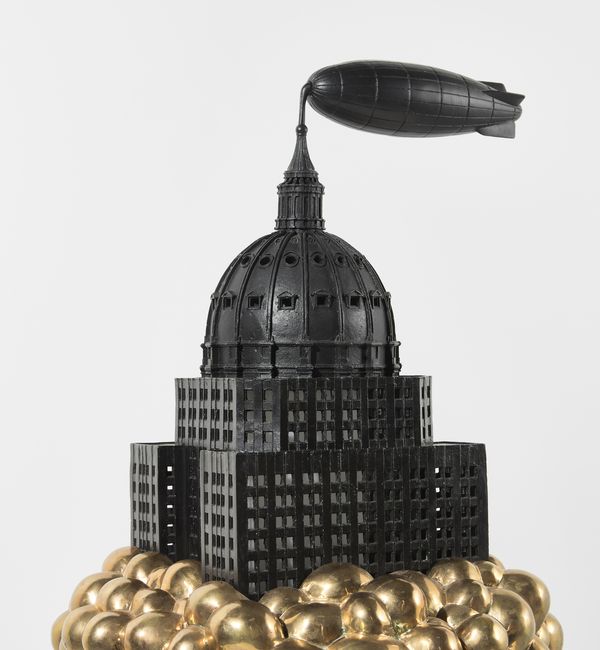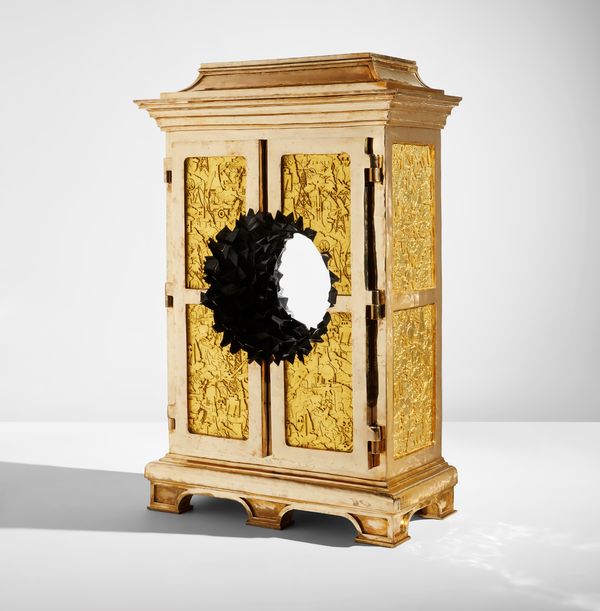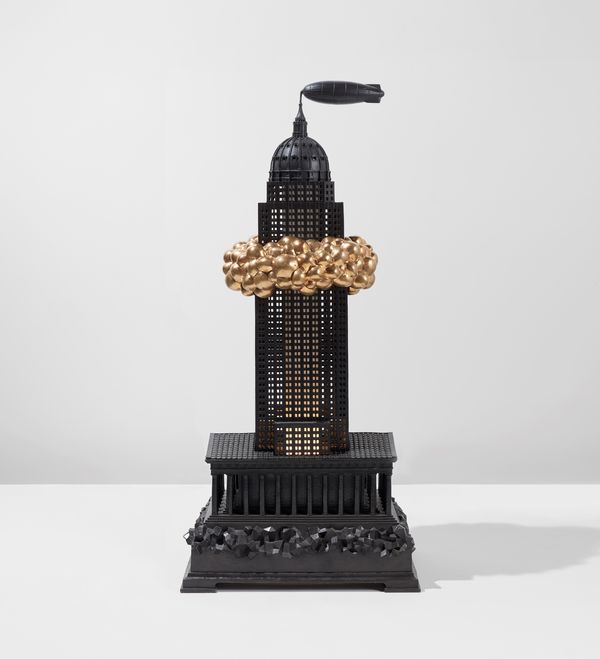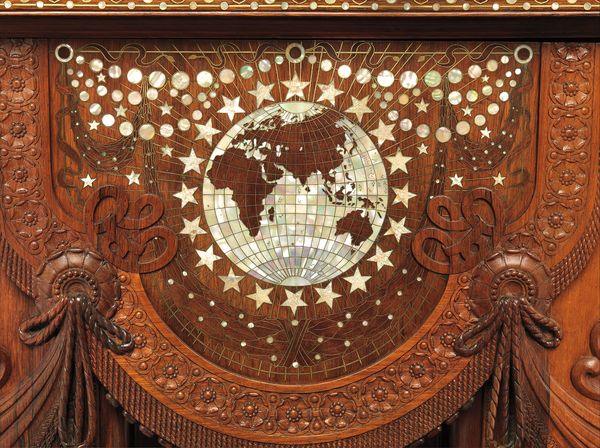Studio Job, detail of floor lamp from the "Robber Baron" series, executed 2007. Estimate: $40,000 - 60,000. Design at Phillips New York, 29 July.
by Luke T. Baker
Job Smeets and Nynke Tynagel, the duo behind Studio Job, produce conceptual objects, lighting, furniture, and graphics that seem to delight in traversing between design and art, past and present. Their one‐off pieces draw inspiration from high and low culture in equal measure, often exalting everyday objects and iconography with extravagant materials and arcane craft techniques. By adopting a lexicon of symbols and playing with scale, Studio Job’s works deploy a cartoonish humor to offer cheeky commentary on such serious subjects as capitalism, taste, and the legacies of art, design and the decorative arts.
Studio Job released their Robber Baron suite of art furnishings in 2006, on the eve of the most disastrous economic crisis since the Great Depression. This limited-edition collection of five luxurious pieces was imagined as a tongue‐in‐cheek critique of wealth and power, inspired by nineteenth-century tycoons and designed to appeal to the oligarchs of the present day. Originally developed as an edition for Moss Gallery, the series comprises a table, jewel safe, cabinet, clock, and floor lamp, all figural, functional pieces, constructed from iconic works of architecture or modeled after precious objects housed in the world’s great museum collections. The furnishings are exquisitely crafted from cast bronze, with polished and patinated details and gilded passages of graphic relief. But each piece features a surrealistic twist that counters its formality with a touch of irreverence: a hole blasts through the center of the Louis XIV cabinet, a train track to nowhere winds around the mantel clock, clouds of bubbles and piles of rubble serve as unlikely ornamental devices. These mysterious and dreamlike elements lend the objects an allegorical quality and invite contemplation of their larger symbolic significance.
Studio Job, cabinet from the "Robber Baron" series, executed 2007. Estimate: $40,000 - 60,000. Design at Phillips New York, 29 July.
The massive, cast‐and polished bronze cabinet from the series is inspired by a 17th-century wardrobe designed by André‐Charles Boulle, French ébéniste par excellence and furnituremaker for the court of Louis XIV. A jagged hole blasted clear through its center renders the cabinet ‘ruined,’ however, as though shot with a cannonball at point‐blank range. At once reverential and irreverent, the piece evokes the opulent Ancien Régime, when wealthy patronage and taste yielded sumptuous furnishings by artisans like Boulle, while also conjuring the iconoclastic energy of the populist revolution that toppled and destroyed the French upper class. Whereas the original wardrobe, housed in the Wallace Collection, is decorated with mythological scenes in marquetry meticulously applied by hand, the Studio Job cabinet nods toward industrialization with its die‐cast bronze panels that feature gilded, low‐relief patterns of apocalyptic accoutrements, among them gas masks, barrels of toxic waste, nuclear cooling towers, grenades, and fighter jets.
Studio Job, floor lamp from the "Robber Baron" series, executed 2007. Estimate: $40,000 - 60,000. Design at Phillips New York, 29 July.
The Robber Baron floor lamp takes the form of a miniature skyscraper encircled by a halo of clouds, complete with a zeppelin docking at its spire. Illuminated from within, the patinated bronze lamp emits light through the building’s frosted glass windows. Standing over five feet tall, this sculptural object is actually a composite of three of the world’s most recognizable buildings: the Parthenon, the Empire State Building, and Saint Peter’s Basilica. Studio Job’s architectural fantasy mashes together these building types both ancient and modern, and in doing so, highlights the common thread that links all three: the symbolic expression of empire. Consolidating the forms creates a trifecta of power, neatly equating democracy (the Classical Greek temple and symbol of Western Civilization at its base), capitalism (the fluted shaft of the Art Deco office building), and religion (the Renaissance dome of the Vatican’s best‐known church).
Detail of the library table designed by the Herter Brothers for William Henry Vanderbilt’s Fifth Avenue mansion, 1879–82. The library table is held in the permanent collection of the Metropolitan Museum of Art, New York.
These works find a precedent in many narrative, symbolically charged buildings, interiors, and furnishings commissioned by the so‐called robber barons of America’s Gilded Age, such as the Rockefellers, Carnegies, Fricks, and Vanderbilts. These newly‐minted millionaires sought out the nineteenth century’s leading craftsmen to create spectacular designs that combined the fashionable taste of the day with references to past styles and loaded iconography, lending the imprimatur of history to families whose wealth and status had only recently been established. A prime example is the magnificent rosewood library table designed in 1882 by the Herter Brothers firm for the Fifth Avenue mansion of William Henry Vanderbilt, who became the country’s wealthiest man after the death of his father, railroad mogul Cornelius Vanderbilt. This object, now belonging to the Metropolitan Museum of Art, employs conspicuous materials and historic motifs to communicate Vanderbilt’s destiny as heir to his family’s legacy. The table’s carved lions‐paw feet and stylized palmettes allude to the grand furnishings of the Roman Empire, while inlays of Napoleonic heraldry recall iconography associated with one of history’s greatest rulers. Globe details on either end tell of Vanderbilt’s boundless domain. A mother‐of‐pearl constellation inlaid on the table’s surface even memorializes the position of the stars on the fateful night of William’s birth.
Studio Job, cabinet from the "Robber Baron" series, executed 2007. Estimate: $40,000 - 60,000. Design at Phillips New York, 29 July.
The Robber Baron series reflects a fascination with narratives of power and prestige embedded within historical objects like the Vanderbilt library table. Through the self‐conscious use of symbol and style, Studio Job create hyper-referential meta‐works that both celebrate and critique these traditions of myth-making within the decorative arts.

Discover More from our international team of specialists and cataloguers




